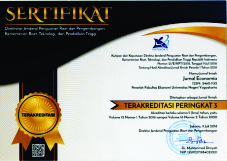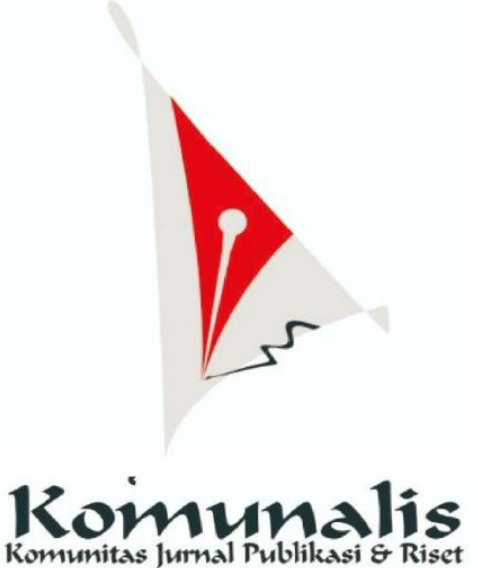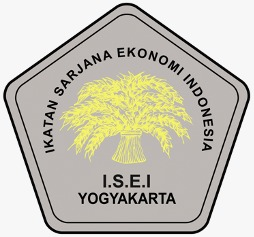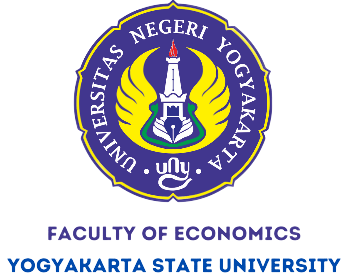The Impact of Islamic Banking Financing on Economic Growth in Indonesia
Downloads
The optimization of the financial intermediation function is one of the primary goals of Law Number 4 of 2023. This regulation assigns a role to Islamic banking in carrying out intermediation, including financing. Therefore, this study aimed to determine the effects of Islamic banking financing on economic growth in Indonesia, using Novel Dynamic ARDL Simulation approach with time series data from 2009Q1 to 2022Q4. The results showed that work capital (WCP) and investment (INV) were significantly, positively, and dynamically related to economic growth (GDP) in the short and long terms, with consumption (CON) having a relevant and negative association. Policy simulation scenarios also proved that a 5% increase in WCP and INV encouraged GDP to the 20th quarter of the experimental year. In this context, the marginal impact of the variables sustained long-term economic growth in a positive trend after financing threshold point.
Downloads
Adzimatinur, F., & Manalu, V. G. (2021). The effect of islamic financial inclusion on economic growth: A case study of islamic banking in Indonesia. Budapest International Research and Critics Institute (BIRCI-Journal): Humanities and Social Sciences, 4(1), 976–985.
Afandi, M. A. (2021). Contribution of islamic commercial bank financing to East Java economic growth in the era of branchless banking. Journal of Economics Research and Social Sciences, 5(1), 1–12.
Ali, M. H., & Uddin, M. A. (2016). Does Islamic bank financing lead to economic growth: An empirical analysis for Malaysia. Munich Personal RePEc Archive, (41193).
Amien, N. N., & Zulkarnaen, W. (2022). The role of sharia banking on MSMEs that implied on Indonesian economic growth. KOMITMEN: Jurnal Ilmiah Manajemen, 3(1), 29–35.
Andiani, A. R. (2022). Analisis hubungan tingkat kedalaman keuangan syariah dan pertumbuhan ekonomi di Indonesia. Institut Pertanian Bogor. Institut Pertanian Bogor.
Arcand, J.-L., Berkes, E., & Panizza, U. (2012). Too much finance? IMF Working Papers, 2012(161), 1.
Babatunde, O., & Oyedokun, G. E. (2021). Financial intermediation and Nigerian economic growth. International Journal of Social Sciences and Management Review, 4(August), 96–101.
Clement, E. P. (2014). Using normalized bayesian information criterion (Bic) to improve Box - Jenkins model building. American Journal of Mathematics and Statistics, 4(5), 214–221.
Consulting, E. (2013). Islamic finance country index 2012, 218–250.
Drissi, S., & Angade, K. (2019). Islamic financial intermediation: the emergence of a new model. European Journal of Islamic Finance, April(12), 1–6.
Financial Services Authority. (2009-2024). Sharia Banking Statistic 2009-2024. Jakarta: OJK
Furqani, H., & Mulyany, R. (2009). Islamic banking and economic growth: Empirical evidence from Malaysia. Journal of Economic Cooperation and Development, 30(2), 59–74.
Grassa, R., & Gazdar, K. (2014). Financial development and economic growth in GCC countries: A comparative study between Islamic and conventional finance. International Journal of Social Economics, 41(6), 493–514.
Gujarati, D. N. (2003). Basic Econometrics (Fourth). McGraw-Hill/Irwin.
Hainmueller, J., & Hazlett, C. (2014). Kernel regularized least squares: Reducing misspecification bias with a flexible and interpretable machine learning approach. Political Analysis, 22(2), 143–168.
IFDI. (2019). Shifting islamic finance development. ICD Refinitiv Islamic Finance Development Indicator, 65–68.
Iryanto, M., Inat, F., & S, F. (2020). Islamic banking financing and economic growth: an Empirical study from Indonesia. Tasharruf: Journal Economics and Business of Islam, 5(2), 147.
Jobarteh, M., & Ergec, E. H. (2017). Islamic finance development and economic growth: Empirical evidence from Turkey. Turkish Journal of Islamic Economics, 4(1), 31–47.
Johansen, S., & Juselius, K. (1990). Maximum likelihood estimation and inference on cointegration — with applications to the demand for money. Oxford Bulletin of Economics and Statistics, 52(2), 169–210.
Kassim, S. (2016). Islamic finance and economic growth: The Malaysian experience. Global Finance Journal, 30, 66–76.
Khasanah, U., Tibrizi, A., & Wicaksono, S. (2021). Intermediary performance of Islamic banks in the disruption era: Does it contribute to economic growth? Banks and Bank Systems, 16(1), 103–115.
Khim, V., & Liew, S. (2004). Which lag length selection criteria should we employ ? Universiti Putra Malaysia: Economics Bulletin, 3(33), 1–9.
Mohd. Yusof, R., & Bahlous, M. (2013). Islamic banking and economic growth in GCC & East Asia countries: A panel cointegration analysis. Journal of Islamic Accounting and Business Research, 4(2), 151–172.
Pesaran, M. H., Shin, Y., & Smith, R. J. (2001). Bounds testing approaches to the analysis of level relationships. Journal of Applied Econometrics, 16(3), 289–326.
Saleem, A., Sági, J., & Setiawan, B. (2021). Islamic financial depth, financial intermediation, and sustainable economic growth: ARDL approach. Economies, 9(2), 1–22.
Soekarni, M. (2011). Dinamika pembiayaan perbankan syariah dalam mengembangkan dunia usia. Jurnal Manajemen Pemasaran, 22, 69–81.
Taufik, M. I. (2023). Analysis of the influence of financing growth based on usage in islamic banking on Indonesian economic growth. Jurnal Muamalat Indonesia - Jmi, 3(1), 286–298.
Zirek, D., Celebi, F., & Kabir Hassan, M. (2016). The islamic banking and economic growth nexus: A panel VAR analysis for organization of islamic cooperation (OIC) countries. Journal of Economic Cooperation and Development, 37(1), 69–100.
Copyright (c) 2025 Jurnal Economia

This work is licensed under a Creative Commons Attribution 4.0 International License.















